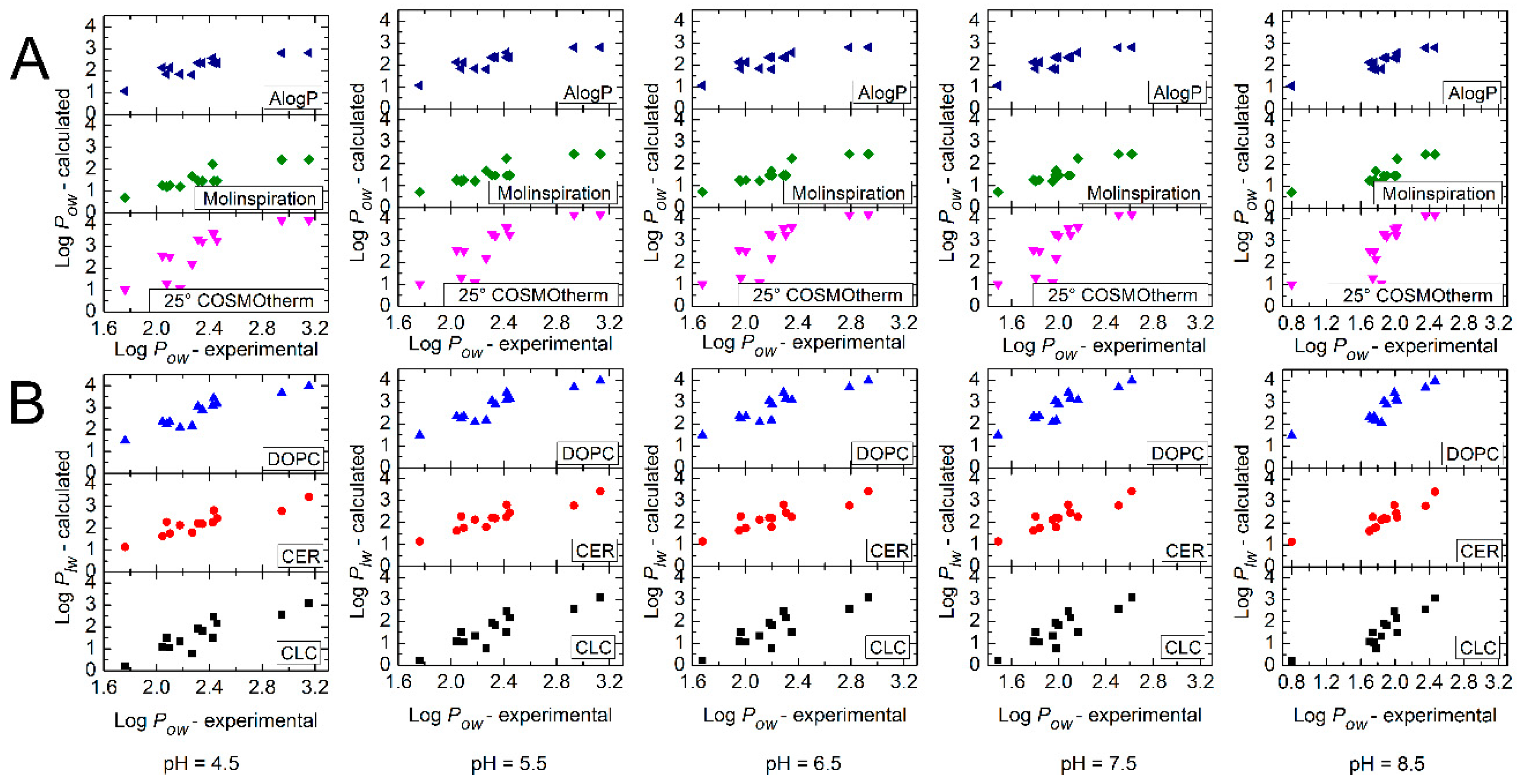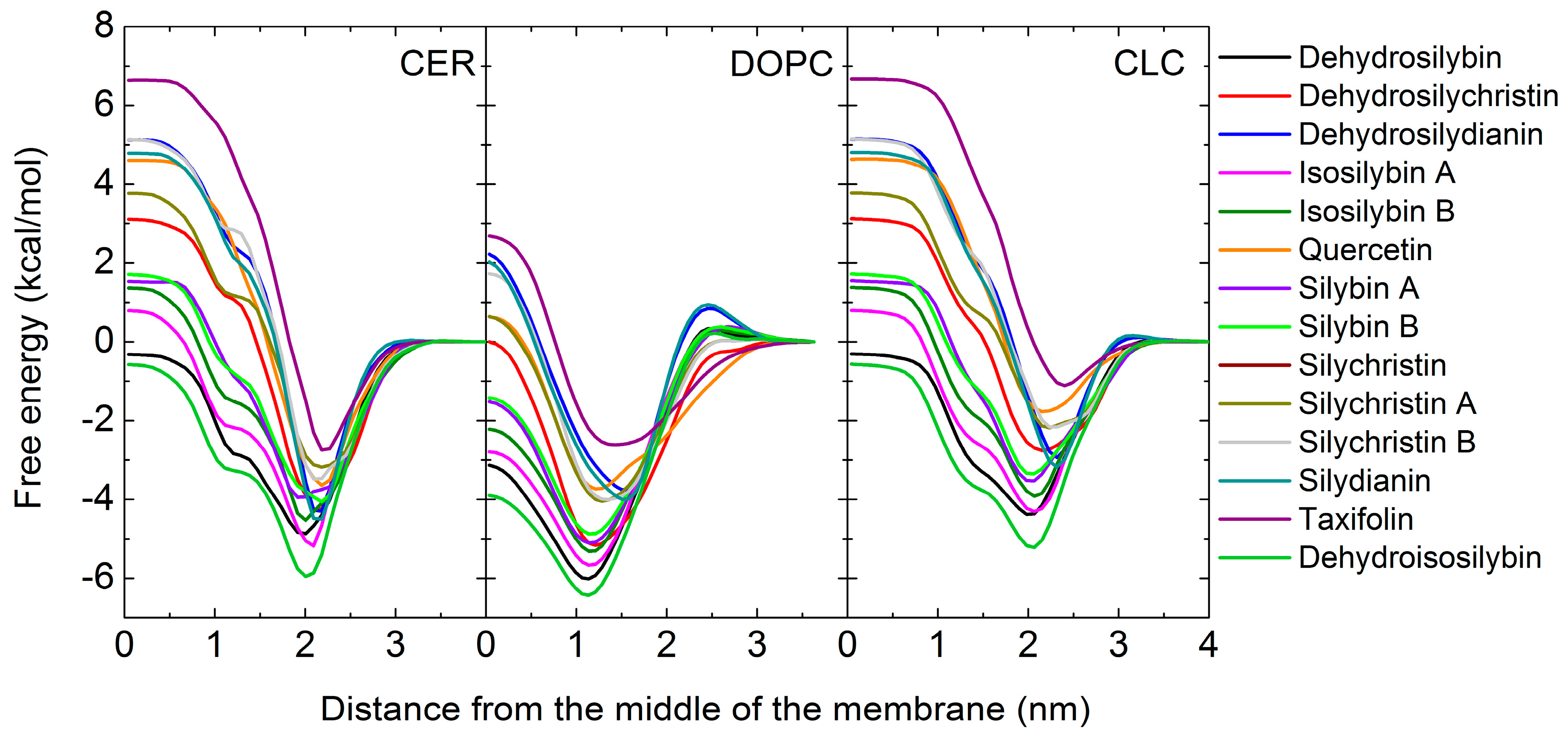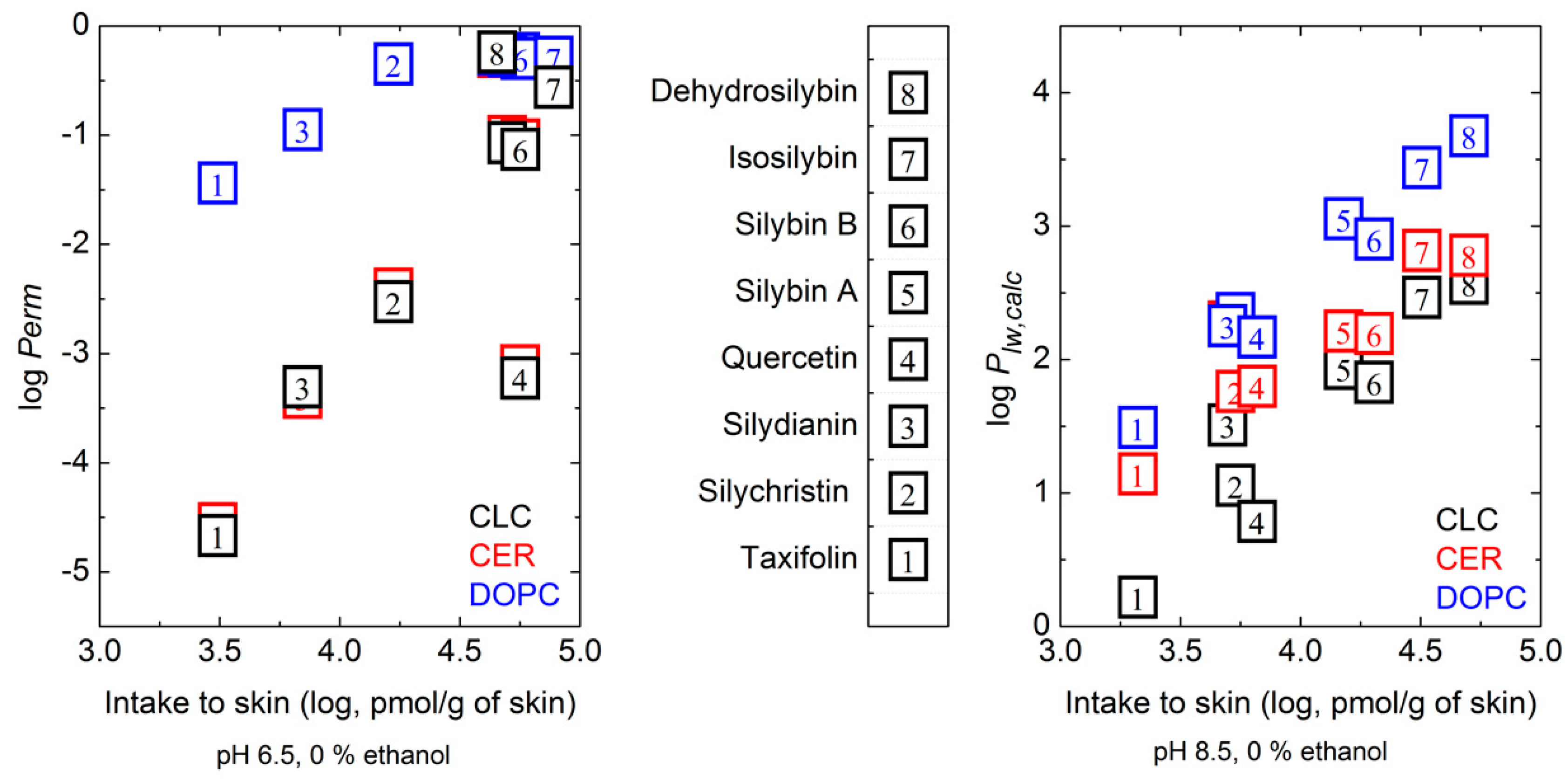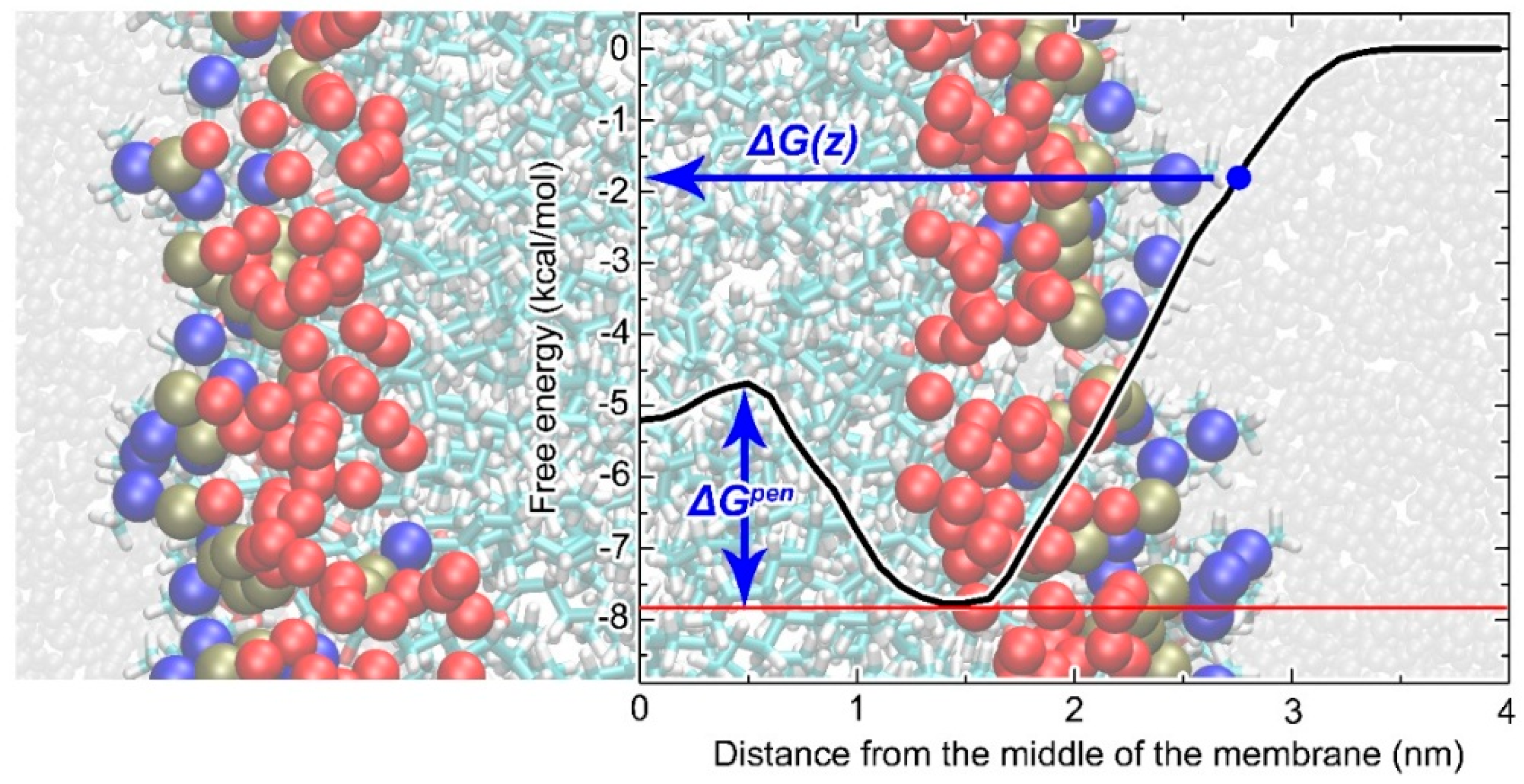2.1. Experimental Partition Coefficients log Pow,exp
The partition coefficients (log
Pow,exp) of studied polyphenols including available diastereomers were obtained using reverse phase HPLC in the pH range of 4.5–8.5. For evaluating the studied compounds’ hydrophobicity, log
Pow,exp of all reference substances were used except for aniline, whose log
Pow,exp value (0.9) was conspicuously lower than that of the other reference substances (their individual log
Pow and applied amounts are presented in Appendix
Table A1). Aniline was only used to evaluate the log
Pow,exp of TA at pH 8.5 due to a big negative shift in the TA log
Pow,exp value.
The relation between the capacity factor
k and log
Pow of reference compounds at various pH of mobile phase, employing quadratic equations, was evaluated. The recommended application of the linear equation [
14] based on reference compound capacity factors (retention times) and log
Pow values for evaluating the test compounds’ log
Pow gave only an r
2 value of 0.89, see
Table A2. The application of the quadratic equation resulted in obtaining more valuable data for the studied compounds’ log
Pow,exp evaluation (r
2 ~ 0.99), see
Table A2. Therefore, the quadratic equations were employed to estimate the log
Pow,exp values of the studied compounds.
A minimal influence of temperature (25 °C ~ recommended by OECD107 [
13]) vs. 32 °C ~ corresponding to the skin surface temperature) on log
Pow,exp values was found (data not shown). Similarly, a minor effect of temperature was found for theoretical (calculation) models (data not shown). The log
Pow,exp values of the studied polyphenols, including data for diastereomers, were evaluated in 5 mM phosphate (
Table 1), additionally in 5 mM formate and 5 mM acetate buffer as well, in a gradient with methanol at 25 °C with the pH range of 4.5–8.5. A minimal effect of mobile phase composition (phosphate vs. formate vs. acetate) was found (
Table 1,
Table A3 and
Table A4). Application of acetate or formate buffers instead of phosphate allows mass spectrometry identification of studied compounds.
Of all the studied compounds, the lowest log
Pow,exp values were found for TA and the highest ones for DISB at all pH values. Among flavonolignans and their dehydro derivatives, SC A exhibited the lowest log
Pow,exp value. The hydrophobicity of flavonolignans in increasing order was as follows: SC A < SD < SC B < DSD < SB A < SB B < DSC < ISB A < ISB B < DSB < DISB. Flavonolignan dehydro derivatives were more hydrophobic than the corresponding parent substances. The same effect was observed with the pair of flavonoids TA and QU. The increasing pH value of the mobile phase decreased the log
Pow,exp value for all polyphenols (
Table 1).
2.6. Calculated Partition Coefficient log Plw,calc and Permeability log Perm Correlation with Polyphenols’ Skin Intake
The experimental skin intake was compared to log
Plw,calc and log
Perm (for data see
Appendix B—
Table A7). For the skin intake at pH 6.5 (no ethanol) after excluding QU, a better correlation was found with log
Perm in CER and CLC membrane models (r
2 = 0.95 and 0.94). The DOPC membrane model did not distinguish well between more hydrophobic compounds, the correlation was lower. For the skin intake at pH 8.5, a correlation was found with log
Plw,calc for all the membrane models used (
Figure 4).
Of the computative log
Pow tools used, the best prediction of log
Plw,calc, was obtained with the DOPC membrane model (r
2 = 0.97). The ethanol content and/or pH increase in the donor liquid influenced the correlation between the skin intake (experimental data) and log
Perm or log
Plw,calc. For both pH values and ethanol content (5 and 10% (
v/
v)) a decrease in r
2 was observed. At pH 6.5 and an ethanol concentration of 15% (
v/
v) an increase in r
2 was found for all membrane models (for data see
Appendix B Table A7). A clear linear dependence was found between log
Perm and the skin intake for the less hydrophobic compounds (TA, SD, SC). The calculation was unable to clearly distinguish between the highly hydrophobic compounds, as
Perm depended exponentially on the highest free energy. The hydrophobic compounds with high log
Plw,calc (affected primarily by the lowest free energy well—see Material and Methods section: Design of computational of hydrophobicity of polyphenols)—did not show any significant dependence of the skin intake on log
Perm at the DOPC membrane. For other membrane models, where the penetration free energy barrier is higher than with DOPC (
Figure 3,
Table 4), a dependence of skin intake on log
Perm over the whole range was found, however with two outliers, DSB and QU.
2.7. Discussions
Despite the use of silymarin in dermatological preparations, a limited amount of information about the hydrophobicity of silymarin’s polyphenols is available. Our study focused on characterizing the hydrophobicity of selected flavonolignans (including diastereomers and dehydro derivatives) and the flavonoids taxifolin and quercetin and their interaction with model membranes and human skin using theoretical and experimental tools.
For compounds with a possible dermal application, it is essential to be able to cross the lipids layer barrier of the
stratum corneum and be soluble in both hydrophobic and hydrophilic environments. These ambivalent properties can be evaluated by the
n-octanol/water partition coefficient [
2]. The official OECD method, based on the partition of a studied compound between the water and
n-octanol phases (
n-octanol/water partition coefficient; log
Pow) measured by the shake flask method, imitates the compound’s interaction with the biomembrane very well [
13]. In this way the log
Pow also characterizes the partitioning of a compound between the lipophilic
stratum corneum and the underlying hydrophilic living cells of the epidermis [
2]. Today, instead of the shake flask method, another OECD Guideline, Test No. 117 using isocratic HPLC elution was applied [
14], but in gradient elution mode [
19]. The methods for log
Pow evaluation are based on a comparison of the log
Pow values of a set of reference compounds and their retention times (capacity factors) in a C
18 chromatographic column with retention times and capacity factors of studied compounds [
14]. The application of the HPLC method for estimating the log
Pow values of polyphenols has several advantages: a stable temperature during analysis, the application of small amounts of pure studied compounds as well as their mixtures with similar structure and/or similar physico-chemical properties. By the HPLC gradient elution method, the mixture of main constitutive
S. marianum flavonolignans (SB, SC, SD, ISB), including diastereomers for SB, SC and ISB, and their respective dehydro derivatives (eleven individual compounds) as well as TA and its dehydro derivative QU could be separated in one run and the obtained data were suitable for the evaluation of log
Pow,exp values (
Table 1).
Data for individual diastereomers of SB, SC and ISB as well as for DISB are published here for the first time. The log
Pow,calc values that we found for QU and TA (
Table 2) are in agreement with reports by Maroziene et al. [
20]. The log
Pow,exp value of QU corresponds to the data by Rothwell et al. [
21]. Similarly, the log
Pow,exp values for the pair of flavonolignans DSB and SB obtained by the shake flask method published by Gažák et al. [
22] agree with our data obtained by the HPLC method. Here we further found that the hydrophobicity of SM’s compounds decreased with increasing pH in all applied solutions (mobile phases), which corresponds to the results for TA, SB, ISB, SC, SD obtained by the shake flask method [
23]. A small effect of pH on log
Pow,exp was observed at pH from 4.5 to 6.5. An obvious decrease in hydrophobicity (log
Pow,exp) was found from pH 6.5 to 8.5 (
Table 1). This phenomenon is connected with the ionization of ionizable groups in the studied compounds. The pK
a1 value of SB, SC, SD [
24], TA [
25] and QU [
26] is close to neutral pH (~7.0) and pK
a2 is ~8.5. The strongest decrease in log
Pow in the case of TA at pH 8.5 relates to its pK
a values (pK
a1 7.1; pK
a2 8.6; pK
a3 8.59; pK
a4 11.82) [
25] as well. Generally, the neutral form of the molecule is more lipophilic than the deprotonated one. The order of the log
Pow,exp of the studied polyphenols (TA, SB, SC, SD and ISB) was not the same as that found by Zeng et al. [
23]. It could be caused by the experimental limitations of the shake flask method. Studied compounds can occur in both phases and also in an interphase; this phenomenon is eliminated in the reverse phase chromatography method used in our study.
The experimental evaluation of compound hydrophobicity is time-consuming, experimentally (the shake flask method) and financially (reverse phase HPLC based approaches) demanding and also unfavorable to the environment (does not follow green chemistry approaches) [
19]. Currently a large number of sophisticated computational tools, based on various parameters, are available [
17,
27,
28]. These in silico methods are helpful for screening a large set of compounds and for basic behavior classification in terms of compound hydrophobicity and bioavailability, reducing the amount of in vivo experiments or clinical trials [
29]. On the other hand, the theoretical methods have some limitations, including the inability to properly simulate all situations in a real biological system (i.e., skin). In our study the tools COSMOtherm 15, AlogP and Molinspiration were used. COSMOtherm 15 is generally focused on the partitioning between fluid phases and not directly on log
Pow, and does not consider the pH effect; therefore, it scored worst of the calculation methods used. At pH 4.5–7.5, the highest correlation was obtained with Molinspiration and at pH 8.5 with AlogP. This may be caused by AlogP’s use of electrotopological state descriptors [
30]. This is an atomic approach that also considers the valence state of the atoms, which may better reflect the experimental molecule ionization at pH 8.5 (corresponding to the pK
a of studied polyphenols). AlogP and Molinspiration tools are based on a large set of experimental log
Pow values and both are applicable around neutral pH. None of the theoretical tools used were able to reflect the behavior of the set of polyphenols over the whole pH range (4.5–8.5). According to the correlations obtained, the choice of optimal log
Pow calculation tool should consider the desired real experimental conditions ~ the real applicative conditions of the compound. When the studied polyphenols are in ionized form (pH over pK
a) only the AlogP tool is able to estimate log
Pow,calc values. At pH below pK
a, Molinspiration described the system best. The replacement of
n-octanol with lipid membrane models (DOPC, CER or CLC) in COSMOmic improved the prediction strength. COSMOtherm and COSMOmic inputs are a 3D structure of the compound (conformational variability is considered) [
18] and thus differentiation between diastereomers A and B is possible. The differences in the hydrophobicity of the diastereomers were too small to distinguish them, and this ability remains a benefit of experimental evaluation. ALogP and Molinspiration tools do not work with diastereomerism.
Although
n-octanol/water partitioning log
Pow is taken as a gold standard for lipophilicity estimation [
19], considering the lipophilicity directly in terms of the lipid/water partition coefficient log
Plw predicts it better. However, using theoretical approaches to characterize the transdermal delivery in vivo is still complicated due to the complexity of the systems in terms of composition or the real interaction between human skin tissue and a topically applied compound. Therefore, both approaches were applied in our study. Many papers have demonstrated that increasing lipophilicity increases the skin permeation of compounds, and a log
Pow of 2–3 seems to be optimal. It is likely that these molecules with intermediate lipophilicity can permeate via both the lipid and polar microenvironments in the intercellular route [
31]. Accordingly, most of the studied polyphenols are good candidates for dermal application, especially at acidic pH (4.5–6.5), see
Table 1. Our transdermal transport data demonstrated that none of the studied compounds were able to penetrate through the skin, as none of them were detected in the acceptor liquid. However, all the polyphenols were found in the human skin (
Table 3). In this way the human skin works as a trap and only the skin intake (accumulation) of polyphenols can be measured. QU skin intake should be taken with care, as the presented results on human skin were affected by QU instability in aqueous solutions that was previously reported [
32]. Thus, with QU it is not possible to ensure a constant QU concentration in the donor liquid during experiments (24 h) as with the other studied polyphenols. Due to QU decomposition, the amount in the skin is most likely significantly reduced. A higher instability of QU occurs in alkaline pH [
32], which corresponds with a lower amount of QU in the skin at the higher pH of 8.5 in our experiments (
Table 3). Therefore, correlations of the polyphenol skin intake with log
Perm and log
Plw,calc were performed without QU.
Although the long-term practical use of silymarin, flavonolignan skin delivery is poorly documented. The previous work [
33] that studied the in vitro delivery of SB, SD and SC using native, chemically, and physically modified mouse skin does not agree with our results (
Table 3). In the mouse models, the flavonolignans were able to penetrate through the skin into the acceptor liquid (SB > SD > SC). However, the human skin has a higher barrier function (more robust
stratum corneum and thicker epidermis) than mouse skin and so mouse skin is not a fully accepted model to mimic the penetration of compounds through the human skin [
34]. Nevertheless, SB deposition in mouse skin was notably higher than those of SC and SD [
33], which corresponds to our data (
Table 3). The order of polyphenol permeation through CER and CLC membrane models (
Table 4) also partially agrees with the published data on mouse skin [
33]. According to our data on the experimental skin uptake, the studied polyphenols can be divided into two groups: low intake (TA, SC, SD) and high intake (SB, DSB, ISB). This division also corresponded to their hydrophobicity based on theoretical data (log
Pow,calc, log
Plw,calc) and experimental log
Pow values as well. Our results further showed a significant effect of pH on the skin intake of flavonolignans and flavonoids. All these properties may be important for designing dermal preparations containing these polyphenols.












